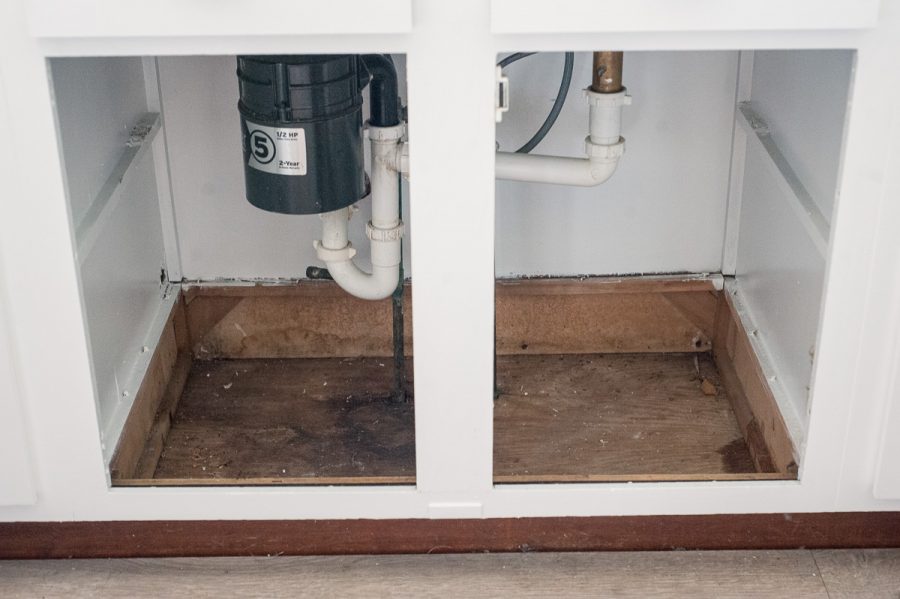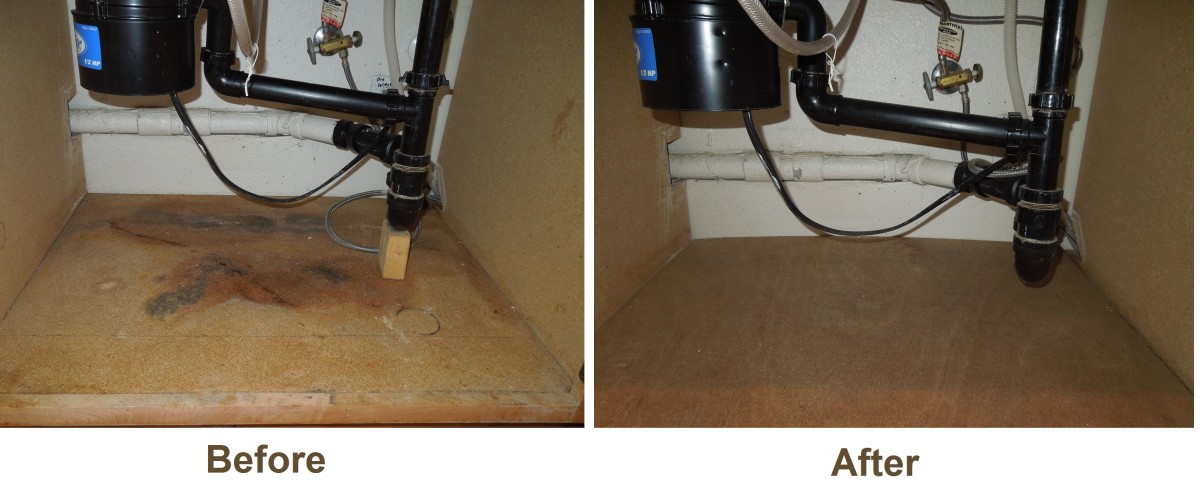Understanding the Need for Replacement: Replace Sink Base Cabinet Floor

The sink base cabinet floor is a crucial part of your kitchen, bearing the weight of your sink and its contents. Over time, this floor can wear down, leading to various problems. Understanding the reasons for replacement and recognizing the signs of damage can help you avoid potential issues and maintain a functional kitchen.
Signs of a Damaged Sink Base Cabinet Floor
A damaged sink base cabinet floor can manifest in several ways, indicating a need for replacement.
- Sagging or bowing: This is a clear sign of structural weakness, indicating the floor can no longer support the weight of the sink and its contents.
- Water damage: Exposure to water can cause the floor to warp, rot, or become moldy. This can compromise the cabinet’s structural integrity and create a health hazard.
- Cracks or splinters: These indicate a weakened floor that is prone to further damage and can lead to instability.
- Squeaking or creaking: These sounds can be an early warning sign of a deteriorating floor.
Potential Consequences of Ignoring a Damaged Sink Base Cabinet Floor
Ignoring a damaged sink base cabinet floor can lead to several undesirable consequences, affecting the functionality and safety of your kitchen.
- Sink instability: A weakened floor can cause the sink to become unstable, potentially leading to leaks, damage, or even collapse.
- Water damage: A damaged floor can allow water to seep into the cabinet, leading to rotting, mold growth, and structural damage.
- Safety hazards: A damaged floor can become a safety hazard, posing a risk of falling objects or collapse.
Choosing the Right Replacement Material

Replacing the floor of your sink base cabinet is a crucial step in restoring its functionality and aesthetics. The choice of material directly impacts the durability, moisture resistance, and overall lifespan of your cabinet. Let’s explore the key materials and their suitability for this task.
Plywood
Plywood is a popular choice for cabinet construction due to its strength and affordability. It’s made by layering thin sheets of wood veneer with alternating grain directions, resulting in a stable and resilient material. However, plywood can be susceptible to moisture damage, especially when exposed to prolonged dampness.
Plywood is generally a good choice for replacing sink base cabinet floors if the area is well-ventilated and not prone to excessive moisture.
Medium-Density Fiberboard (MDF)
MDF is a wood-based panel made from wood fibers that are bonded together with resin. It offers a smooth, consistent surface, making it ideal for painting or laminating. However, MDF is not as moisture-resistant as plywood and can swell or warp when exposed to water.
MDF is a good option for replacing the floor of a sink base cabinet if the area is dry and the cabinet is not subjected to frequent spills or splashes.
Composite Materials
Composite materials, such as moisture-resistant plywood or engineered wood products, are specifically designed for applications where moisture resistance is crucial. These materials often incorporate waterproof coatings or core layers that provide excellent protection against water damage. They are generally more expensive than plywood or MDF but offer superior durability and moisture resistance.
Composite materials are the best choice for replacing the floor of a sink base cabinet in areas prone to moisture, such as under a kitchen sink or bathroom vanity.
Step-by-Step Replacement Process

Now that you’ve gathered your materials and made your decision, let’s dive into the actual process of replacing your sink base cabinet floor. This step-by-step guide will help you navigate the process smoothly and achieve a professional finish.
Preparing the Cabinet
Before you start, it’s crucial to prepare the cabinet for the replacement process. This ensures a clean, safe, and efficient workflow.
- Clear the Cabinet: Remove all items from the cabinet, including dishes, utensils, and cleaning supplies. This provides a clear working space and prevents accidental damage.
- Disconnect Water Supply: Turn off the water supply to the sink. This is essential to prevent leaks during the removal process. You can usually find the shut-off valve under the sink or near the water meter.
- Disconnect Plumbing: Carefully disconnect the sink’s drain and water supply lines. This step might require a wrench or adjustable pliers. If you’re unsure, consult a plumber for assistance.
- Remove the Sink: Once the plumbing is disconnected, you can remove the sink. This might involve unscrewing mounting brackets or using a utility knife to cut through any sealant holding the sink in place.
Removing the Existing Floor, Replace sink base cabinet floor
With the cabinet prepared, it’s time to remove the old floor. This step requires careful attention to avoid damaging the surrounding cabinet structure.
- Identify the Floor Material: Determine the material of the existing floor. This could be plywood, particleboard, or even a combination of materials. Knowing the material helps you choose the appropriate removal technique.
- Use a Pry Bar: If the floor is plywood or particleboard, a pry bar can be used to loosen and remove the panels. Start by inserting the pry bar under the edge of the floor and gently leverage it upwards. Be cautious not to damage the cabinet walls.
- Remove Fasteners: Once the floor panels are loose, remove any nails or screws holding them in place. If the floor is glued down, you might need a scraper or chisel to remove it carefully.
- Inspect the Subfloor: After removing the old floor, inspect the subfloor for any damage or rot. If you find any issues, address them before installing the new floor.
Installing the New Floor
With the old floor removed and the subfloor inspected, you’re ready to install the new floor. This step involves carefully positioning and securing the new material.
- Measure and Cut: Measure the dimensions of the cabinet floor and cut the new material to size. Use a saw, jigsaw, or circular saw for precise cuts. Ensure the new floor is slightly smaller than the opening to allow for expansion and contraction.
- Apply Adhesive: If using plywood or particleboard, apply a construction adhesive to the subfloor. This creates a strong bond between the new floor and the existing structure. Follow the manufacturer’s instructions for application and drying time.
- Position the New Floor: Carefully position the new floor panel over the subfloor, ensuring it’s level and flush with the surrounding cabinet walls. You can use shims to adjust the height if necessary.
- Secure the Floor: Depending on the material, you can secure the new floor with screws, nails, or construction adhesive. Follow the manufacturer’s recommendations for appropriate fasteners and placement.
Sealing the Edges
Once the new floor is installed, it’s important to seal the edges to prevent moisture damage and ensure a professional finish.
- Apply Caulk: Use a silicone-based caulk to seal the gaps between the new floor and the cabinet walls. Apply a thin bead of caulk along the edges and smooth it with a damp finger or a caulk tool. Allow the caulk to dry completely before proceeding.
- Paint or Stain: If desired, you can paint or stain the new floor to match the rest of the cabinet. Apply a primer first, followed by your chosen paint or stain. Allow each coat to dry thoroughly before applying the next.
Replace sink base cabinet floor – Replacing the floor of your sink base cabinet can be a surprisingly involved project. You’ll need to consider the weight distribution of your sink and plumbing, and maybe even factor in a bit of DIY magic. If you’re looking for a simpler project that can transform your space, try this ikea bedroom bench hack for a cozy and stylish addition to your bedroom.
Once you’ve mastered that, you’ll be ready to tackle even the most challenging sink base cabinet floor replacement.
Replacing the floor of your sink base cabinet can be a surprisingly satisfying DIY project. It’s a great way to freshen up your kitchen without breaking the bank. And if you’re looking for a new place to put your newly renovated kitchen, maybe check out san mateo one bedroom apartments.
Finding the perfect apartment can be just as satisfying as a successful DIY project! But once you’ve settled in, that sink base cabinet floor might need another update – it’s a cycle, really.